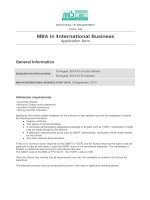International business 7e czinkota moffett ch05
Bạn đang xem bản rút gọn của tài liệu. Xem và tải ngay bản đầy đủ của tài liệu tại đây (785.05 KB, 26 trang )
Chapter 5
The Theory of Trade
and Investment
1
Learning Objectives
To understand the traditional arguments
of how and why international trade
improves the welfare of all countries
To review the history and compare the
implications of trade theory from the original
work of Adam Smith to the contemporary
theories of Michael Porter
To examine the criticisms of classical trade
theory and examine alternative viewpoints of
which business and economic forces
determine trade patterns between countries
To explore the similarities and distinctions
between international trade and
international investment
2
Evolution of Trade Theory
The Age of Mercantilism
Classical Trade Theory
Factor Proportions Trade
Theory
International Investment
and Product Cycle Theory
The New Trade Theory:
Strategic Trade
The Theory of
International Investment
3
The Age of Mercantilism
The evolution of trade into
the form we see today
reflects
three events:
The Collapse of Feudal Society
The Emergence of the Mercantilist Philosophy
The Life Cycle of the Colonial Systems of the
European Nation-States
4
Mercantilism
Mixed exchange
through trade with
accumulation of wealth
Conducted under
authority of
government
Demise of mercantilism
inevitable
5
Classical Trade Theory
The Theory of Absolute Advantage
The ability of a country to produce a
product with fewer inputs than
another country
The Theory of Comparative Advantage
The notion that although a country
may produce both products more
cheaply than another country, it is
relatively better at producing one
product than the other
6
Classical Trade Theory Contributions
Adam Smith—Division of Labor
Industrial societies increase output using
same labor-hours as pre-industrial society
David Ricardo—Comparative
Advantage
Countries with no obvious reason for
trade can specialize in production, and
trade for products they do not produce
Gains From Trade
A nation can achieve consumption levels
beyond what it could produce by itself
7
Factor Proportions Trade Theory
Developed
Developedby
byEli
EliHeckscher
Heckscher
Expanded
Expandedby
byBertil
BertilOhlin
Ohlin
8
Factor Proportions Trade Theory
Considers Two Factors of Production
Labor
Capital
9
Factor Proportions Trade Theory
A country that is relatively
labor abundant (capital
abundant) should specialize
in the production and export
of that product which is
relatively labor intensive
(capital intensive).
10
The Leontief Paradox
The Test:
Could Factor Proportions Theory be used to explain the types of goods
the United States imported and exported?
The Method:
Input-output analysis
11
The Leontief Paradox
The Findings:
The U.S. exported labor-intensive products and imported capitalintensive products.
The Controversy:
Findings were the opposite of what was generally believed to be true!
12
Overlapping Product Ranges Theory:
Staffan Burenstam Linder
Trade in manufactured goods dictated not by cost concerns, but by
similarity in product demands across countries.
Work focused on preferences of consumer demand.
Today, termed market segments.
13
Product Cycle Theory
Raymond Vernon
Focus on the
product, not its
factor proportions
Two technologybased premises
14
Product Cycle Theory:
Vernon’s Premises
Technical innovations leading to new and profitable products require large
quantities of capital and skilled labor
The product and the methods for manufacture go through three stages of
maturation
15
Stages of the Product Cycle
The New Product
The Maturing Product
The Standardized Product
16
The Product Cycle and Trade
Implications
Increased emphasis on
technology’s impact on product
cost
Explained international investment
Limitations
Most appropriate for technology-based
products
Some products not easily characterized by
stages of maturity
Most relevant to products produced through
mass production
17
The New Trade Theory:
Strategic Trade
Two New Contributions
Paul Krugman-How trade is altered when markets are not perfectly
competitive
Michael Porter-Examined competitiveness of industries on a global
basis
18
Strategic Trade
Krugman’s Economics of
Scale:
Internal
InternalEconomies
Economiesof
ofScale
Scale
External
ExternalEconomies
Economiesof
ofScale
Scale
19
Strategic Trade
Government can play a beneficial role when markets are not purely
competitive
Theory expands to government’s role in international trade
Four circumstances exist that involve imperfect competition in which
strategic trade may apply
20
Strategic Trade
The Four Circumstances Involving Imperfect Competition:
Price
Price
Repetition
Repetition
Cost
Cost
Externalities
Externalities
21
Strategic Trade
Porter’s Diamond of National
Advantage
Innovation is what drives and sustains
competitiveness
Four components of competition
Factor Conditions
Demand Conditions
Related and Supporting Industries
Firm Strategy, Structure, and Rivalry
22
Michael Porter’s Competitive Clusters
Critical masses of
unusual
competitive
success in
particular fields,
located in one
place
23
The Theory of International
Investment
The movement of capital
has allowed foreign direct
investments across the
globe
24
The Theory of International
Investment
Firms as Seekers
Seeking
Seeking
Seeking
Seeking
Seeking
Resources
Factor Advantages
Knowledge
Security
Markets
25









